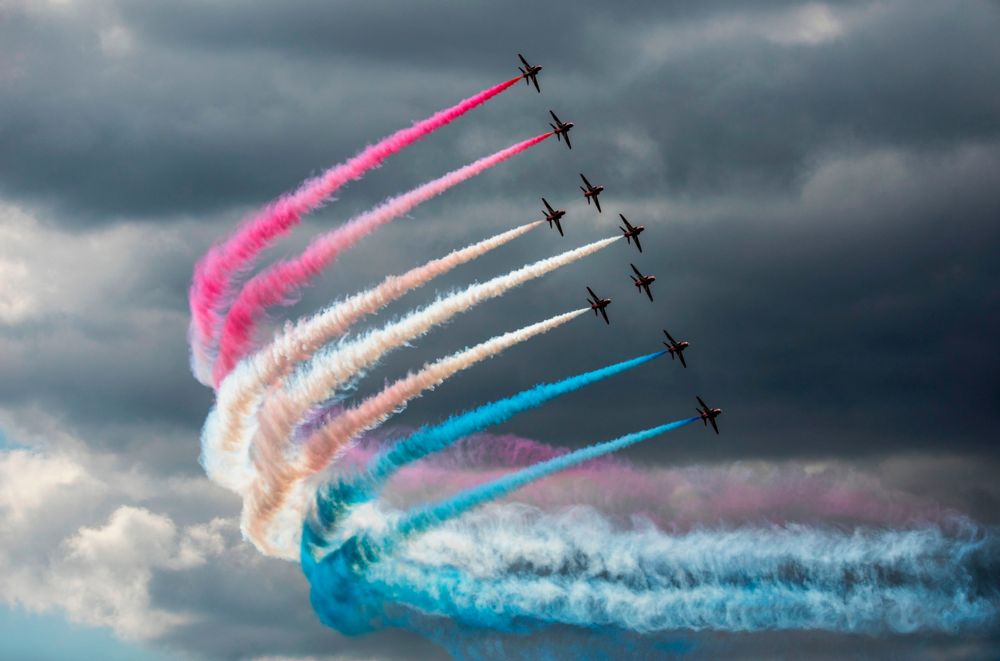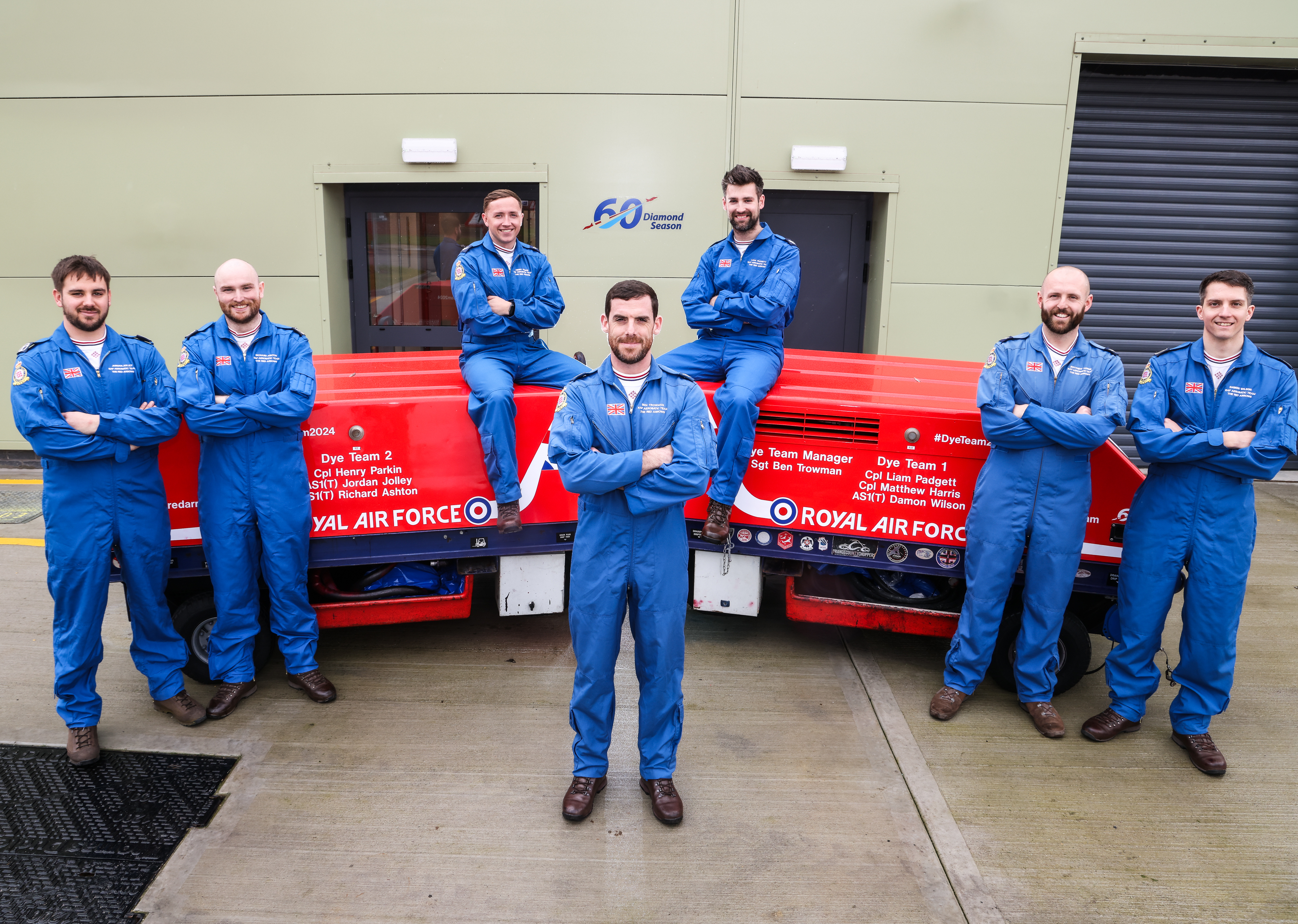Pilots
All Red Arrows display pilots are fast-jet pilots, having previously flown with frontline Royal Air Force squadrons.
Once they have finished their tour with the team - usually three years in total - they will return to operational, training, staff duties or other roles in the Royal Air Force.
How did they become Red Arrows pilots?
RAF pilots must meet these criteria to apply for selection to the Red Arrows:
- Have a minimum of 1,500 flying hours
- Have completed a frontline, operational tour
- Be assessed as being above average in their flying role
A shortlist of up to nine applicants are examined during a thorough selection week, and are put through a gruelling flying test, formal interview, media test and peer assessments.
Up to three new pilots are chosen each year to replace the three that have finished their tour. The Team Leader must have completed a three-year tour as a team pilot earlier in their career and is appointed in a separate selection process.
Support team
It is the hard work of the team’s support personnel that keep the Red Arrows flying.
The teamwork shown by the pilots in the air is reflected in the dedication and professionalism of the support staff on the ground. The support team’s success results from their Royal Air Force training, the pride they take in their work, and their determination, motivation, and, very often, sheer hard work. Without them, the Red Arrows could not function.
This team is made up of a Chief of Staff, a Public Relations Manager, Mission Support Flight commander, Operations Officer, Engineering Officers, an Adjutant and approximately 120 engineering technicians and other support staff.
The latter are known as ‘The Blues’ because they wear distinctive royal blue flying suits during the display season. The Blues represent several of the Royal Air Force’s broad range of professions. Every team member has undergone intensive training in their particular specialisation throughout their Royal Air Force career.
Circus
Ten aircraft engineering technicians and one photographer are chosen to form a team known as the Circus.
Circus members are each allocated to a specific pilot for the duration of the summer display season.
They fly in the passenger seat of the Hawk to and from display airfields and service the aircraft before and after every display when operating away from the team's home base. Once the display season is over, they return to their normal team duties.
The unique experience of flying regularly in a fast-jet means that these are some of the most sought-after engineering and technical jobs in the Royal Air Force.
Engineering - 'The Blues'
.jpeg)
The Red Arrows' engineering technicians and support staff are headed by a Senior Engineering Officer who, along with a management team of two Junior Engineering Officers, Engineering Support Flight officer, a Warrant Officer and two Flight Sergeants, is responsible for ensuring the correct number of aircraft are available for the pilots during both the display and training seasons and that the jets undergo the appropriate servicing and maintenance. They coordinate engineering standards and safety plus the welfare of the Red Arrows' engineering team.
Mechanical technicians
Mechanical technicians make up two thirds of the Red Arrows’ engineering team and are responsible for the maintenance and rectification of the Team’s BAE Systems Hawk T1 aircraft. The mechanics look after the complete range of mechanical components and structure of the aircraft including the engines, gearboxes, flying controls, landing gear, hydraulics, air conditioning, anti-icing and fuel systems – everything from the smallest nut and bolt to the wings.
Avionics technicians
The Red Arrows have 14 avionics technicians who are responsible for all the electrical and avionics systems on the aircraft. They maintain equipment ranging from emergency compasses to complex engine control circuits, as well as introducing upgrades such as new radio systems and engine performance monitoring equipment.
Weapon technicians
The smallest of the Red Arrows’ three engineering trades, the weapons technicians are responsible for the maintenance and control of the explosive components and survival equipment fitted to the Hawk aircraft. The team work on the aircraft’s ejection seats, explosive canopies and fire suppression and emergency systems.

Logistics
Responsibility for ensuring spare parts get to the Red Arrows wherever they are operating throughout the world falls upon the five-strong supply team. They also ensure that the team’s transport, whether it is an RAF Airbus A400M Atlas aircraft or an articulated lorry, are correctly loaded. All of the thousands of pieces of equipment that help the Red Arrows work smoothly – everything from nuts and bolts to aircraft engines – are purchased, stored, managed and distributed by the suppliers.
Mechanical Transport
The Red Arrows have eight drivers who are responsible for a fleet of 18 vehicles, from 38-tonne trucks to vans. A vital part of the team, they ensure all the equipment and personnel reaches the right place as well as ensuring the aircraft are refuelled and replenished with the diesel needed for the smoke systems.
Survival Equipment Technicians
The team has three Survival Equipment Technicians who maintain all elements of the pilots’ safety kit. This specialist equipment includes helmets, anti-G trousers, life rafts, oxygen masks and parachutes.
Photographers
Without one of the team’s photographers (officially known as RAF Visual Communications Specialists), the Red Arrows would not be able to display. There are three in the team. Their role is crucial for safety and training purposes and one of the three-strong section videos every manoeuvre of the display from the ground – both during winter training and the summer season. They also take still images for the team, capturing pictures of the jets in action around the world, in the air and on the ground.
Engineering Support Flight
Engineering Support Flight (ESF) is responsible for maintaining quality assurance, standards, support, records and training. The section has a mixture of regular and reserve personnel of various ranks. Support and training is pinnacle within the Red Arrows, ensuring safety and compliance in the air and on the ground, regardless of trade or rank.
Interested in joining the RAF?
Find out more about these and other unique and rewarding roles in the RAF:
Survival Equipment

Dye Team
The Red Arrows are famous for their vibrant vapour trails - often known as the smoke. They are a crucial element of the team's displays, primarily for flight safety. The vapour trails allow Red 1 to judge wind speed and direction, and allow the aircraft to locate each other in the second half of the show when different sections of the formation are frequently several miles apart. The vivid and colourful smoke trails also enhance the visual impact of the display when viewed from the ground. Well known manoeuvres such as the heart, rollbacks and carousel would just not be the same without it.

The Red Arrows have two dedicated dye teams who ensure the aircraft's under-fuselage pods - from which the coloured dye is contained - are replenished. These engineers travel all over the country, working within tight timescales to ensure that when Red 1 makes the call it is "Smoke on, Go!".

History
Since flying the first time in 1965, the Royal Air Force Aerobatic Team has performed more than 4,900 times across the globe. The Red Arrows are lucky to have both a wonderful history and the support and interest of millions of well-wishers.
It was in 1964 when the Royal Air Force amalgamated its display teams into one, premier unit – the Red Arrows. The name was taken from the Black Arrows team and the colour scheme as a tribute to the Red Pelicans, while the aircraft chosen to be flown, the Gnat, had been used by the Yellowjacks.
In the first season of 1965, the team – flying seven aircraft in a display and based at RAF Fairford – performed 65 shows. A media event at RAF Little Rissington on May 6 was the team’s first official display, with the first public performance in the UK on May 15 at Biggin Hill Air Fair. The team permanently increased to nine display aircraft in 1968 and the Diamond Nine became the Red Arrows’ trademark formation.
The Gnat, which had flown 1,292 displays, was replaced by the BAE Systems Hawk, a modified version of the RAF’s fast jet and weapons trainer, for the 1980 season. Also that year, permission was given for the team to have the motto Eclat – meaning excellence.
RAF Scampton – the Lincolnshire station famous for its role in the 1943 Dambusters raid – became the team’s new home in 1983, moving from RAF Kemble – its base since 1966. The Red Arrows temporarily relocated to RAF College Cranwell, also in Lincolnshire, between 1995 and 2000.
During the team’s world tour of October 1995 to February 1996, the Red Arrows performed to nearly a million people in Sydney on Australia Day.
In 2002, the Red Arrows flew with a British Airways Concorde over London to mark Her Majesty The Queen’s Golden Jubilee.
A decade later, the Red Arrows performed another series of flypasts over the capital, for the Queen’s Diamond Jubilee, the 2012 Olympic Games Opening Ceremony – seen by a global television audience in excess of one billion people – and the Athlete’s Parade.
The 4,500th Red Arrows display took place at the RAF Waddington International Air Show in July 2013 – in the team’s 49th season and the year concluded with a highly-successful tour of the Middle East.
In 2014, the 50th display season was marked as a major milestone with a series of celebrations throughout the year. The Red Arrows were the main feature and theme of the year’s airshows. There were also television and radio documentaries, magazines produced and even a high speed train named after the team.
A special, one-off, tailfin was revealed on the team to recognise the anniversary season, with the design incorporating both a Gnat and Hawk jet outline to reflect the two types of aircraft flown by the team in its history.
For the 2015 season, instead of returning to the traditional three-stripe tailfin livery used since the 1960s, a fresh new paint scheme was revealed on the jets during a live television broadcast from RAF Scampton. This Union flag-inspired design features flowing red, white and blue lines and emphasises the Red Arrows’ role as national ambassadors for the United Kingdom.
In September 2016, after a busy domestic season, the team embarked on its biggest overseas tour in a decade. The nine-week deployment to the Asia-Pacific and Middle East regions covered 20,000 miles. The tour took the Red Arrows to 17 countries – including visiting China for the first time in the Squadron’s history. It is estimated the team’s activities were seen by a global audience, in person or through media channels, of up to one billion people. The deployment contributed to the Government’s GREAT campaign, supporting UK interests across business, trade and education and promoting the best of British innovation, technology and creativity.
For 2018, the Red Arrows spearheaded celebrations marking the Royal Air Force's centenary - including providing the colourful finale to a flypast of more than 100 aircraft over central London in July of that year.
In 2019, the team carried out its largest-ever tour of North America, spanning 11 weeks, with award-winning, coast-to-coast performances that reached hundreds of millions of people and supported a range of UK businesses, trade and interests.
A move to a new Lincolnshire home – RAF Waddington – came in late-2022, with the team leaving its celebrated home of RAF Scampton after a near 40-year presence there.
Special artwork was added to the aircraft in 2024 to help mark the team's 60th diamond season.
Team members since 1965









